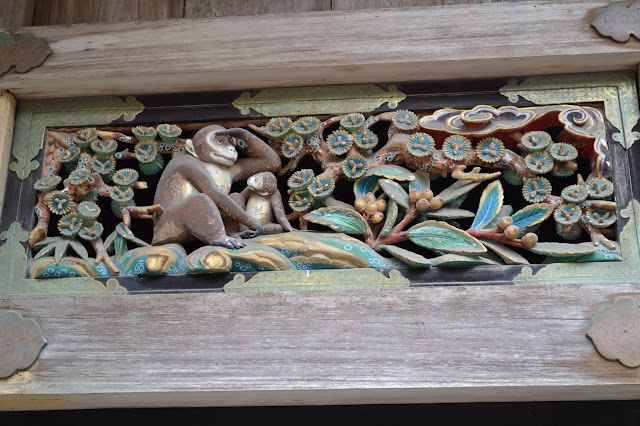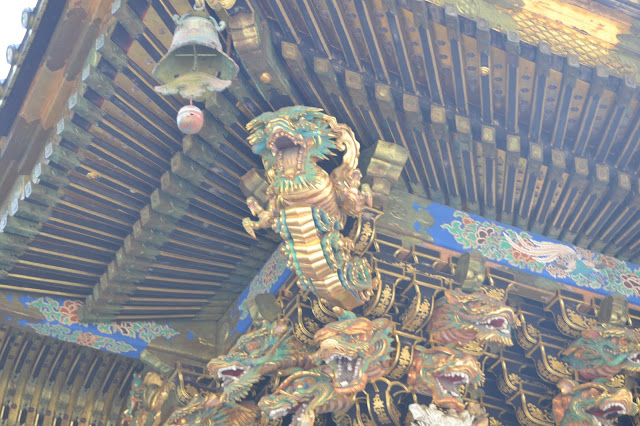Part 2 of the Nikko adventure! Read Part 1 to catch yourself up if you’ve got the
memory of a goldfish or just didn’t plain read it. The nerve.
Toshogu Shrine is the most popular, for good reason. It
contains the enshrined Ieyasu, first off. The next reason is the ever
famous three wise monkeys. Never heard of them, you say? How about the phrase,
“See no evil, speak no evil, hear no evil”? I thought so. That original carving
is here, and is actually part of a story line of the life cycle of the monkey.
 “A mother monkey is looking far into the future of her
child, and a child is looking up at the mother.”
“A mother monkey is looking far into the future of her
child, and a child is looking up at the mother.” “Three monkeys tell us that children should see no
evil, say no evil, and hear no evil.”
“Three monkeys tell us that children should see no
evil, say no evil, and hear no evil.”
“He is about to be independent.”
 “He is ambitiously looking up”
“He is ambitiously looking up” “He is frustrated in life and desperately looking down
the cliff while one of his friends is cheering him up.”
“He is frustrated in life and desperately looking down
the cliff while one of his friends is cheering him up.” “He is love sick.”
“He is love sick.” “A newly-wedded couple are going to sail through the
rough waves of life together.”
“A newly-wedded couple are going to sail through the
rough waves of life together.” “She is an expectant mother, and return to the first
scene.”
“She is an expectant mother, and return to the first
scene.”
This same building is actually the “Sacred Stable”, which holds
two white horses (alas, none there when I was by). The monkeys are thought to
be guardians of horses, hence their presence.
Across from that were the famous “Imaginary Elephants”
carved by the sculptor Tanyu Kano. He made these without ever seeing one
himself (just based off descriptions). Not too bad, if I do say so myself.
Below is a picture of the first bronze Torii in Japan,
called the Karadou-torii. I guess at the base were lotus flowers, which is
apparently strange because lotus flowers are associated with Buddhism. I forgot
to look for them, so no pictures.
At the top of the stairs are two statues of lions that
appear to be jumping… but they actually serve a purpose! Apparently they are
used to stabilize the fence. Those crafty Japanese, combining style with
function.
Next is the famous Yomeimon Gate. It has a lot to notice, such as the multitude of carvings on it which I managed to photograph for your
viewing pleasure.
 Dragons, probably Kirin though
Dragons, probably Kirin though Bad photo of a dragon, but it may actually be a
giraffe. I know, it’s weird.
Bad photo of a dragon, but it may actually be a
giraffe. I know, it’s weird.
This isn’t a very good photo, but the pillar in the center of the photo is inverted (called the Mayokeno-sakabashira) – if you look at the
design, it’s upside down compared to the two on the left. It was believed that
“once a building is completed, its destruction begins”, so they purposely
placed it upside down to act like they were permanently postponing the shrine’s
completion. I think the gods saw through that one though.
Iki or dragon on top of the Karamon Gate, located after the Youmeimon Gate. This serves at the gate for a worship building called Honsha, which used to be limited to only feudal lords or higher. The picture below is a close up.
To see Ieyasu's tomb and another famous carving (Nemuri-Neko, or Sleeping Cat), you have to pay an extra fee... or, you got a combination ticket when buying entry into Toshogu Shrine. Guess who purchased the combination ticket but also paid extra because she stupidly didn’t realize that her pass was the combination one? Oh well, I guess the Buddhist monks need it.
The sleeping cat is famous because it signifies the peace in
the land… there’s a sparrow on the other side that can feel free to fly without
getting eaten because the cat is sleeping. Unfortunately, I thought the sparrow
was on the image with the cat… but luckily someone else online thought to take
a photo of the sparrow, so I will shamelessly steal it for your benefit.
I then made the trek to Ieyasu’s tomb.
His remains are in that cylinder, guarded by the crane and a turtle (symbols of good fortune and longevity). The tree in the background was special and brought some sort of good fortune, but I couldn't find out what.
There’s another part of the shrine where you can hear the
“crying dragon”. It’s an awesome acoustic effect, though I’m not sure why in
particular since the room is fairly square. There’s a giant mural of a dragon
on the ceiling, and if you clap two sticks anywhere in the room except for
under its head, you hear just normal clapping. However, if you clap the sticks
under its mouth, you hear a loud echoing sound, which sounds like a crying
dragon. Or at least, it did to me… though the last time I heard a crying dragon
was a while ago. If you skip to the 3:00 minute mark, you can get the basic idea:
Exhausted and hungry, I made my way back to the hotel, but
not before stopping in another little tiny restaurant owned by an older
Japanese couple. The woman was super excited to help me out and gave me a
thousand brochures on things to do in Nikko. They served me up a wonderful soba
made of Yuba, which is the skin that forms on top when making tofu (Nikko is
famous for this). The woman also wanted to take a photo of me and put it in her
little photo album of foreign visitors, ha. Below is me and her (I'm assuming) husband, the chef.
The next day, after perusing the brochures the lady from
last night had given me, I realized I had been unaware of an entire section
called the Takino’o Path! Thus, I returned to the temples for more.
This is a three-storied pagoda, which apparently has
12 zodiac animals carved under the roof of the first story (forgot to look) and
the Kannon-Do Sacred Hall, which is where Senju-Kannon (1,000-armed Goddess of
Mercy) is enshrined.
Kodama-Do Sacred Hall is where, according to legend,
Kobo Daishi saw two white balls come out of a pond. Believing that they were
incarnations of holy spirits, he built a temple for them. Those balls pulled a
number on him, eh?
 Kaizan-Do Sacred Hall is where the body of Priest
Shodo was cremated.
Kaizan-Do Sacred Hall is where the body of Priest
Shodo was cremated. Next to that is his grave…
Next to that is his grave… …along with his three disciples
…along with his three disciples
Right next to it is the Kannon-Do (or San-no-miya),
which is the Shrine of Safe and Easy Delivery of a Child. Another name is
Kyosha-do, because Kyosha is a piece in Japanese chess that can move forward in
a straight line. I’ll have to take their word for it. The connection between
the two is a straight & easy path toward delivery.
 Behind that was the Hotoke Iwa, which contains six
stone statues of Buddha (called Rokubu-te). They were pretty cool, and it was
weird to just see these statues under a cliff.
Behind that was the Hotoke Iwa, which contains six
stone statues of Buddha (called Rokubu-te). They were pretty cool, and it was
weird to just see these statues under a cliff.
That last one kinda scares me.
The Yin and Yang Stones, symbolizing male and female. I
don’t know how this ever became something important, but I’m sure there’s an
awesome back story.
This is the Kitano Shrine, built in 1661 for Sugawara
Michizane (enshrined as a God of Study). At first I thought it was a pig but I think it's supposed to be a bull. After some research I found multiple reasons why this is so, but I'll only list one particular to Michizane. I guess the bull pulling his remains during the funeral procession refused to go past a certain spot, and thus a shrine (Kitano Shrine -- though not this particular one pictured) was built.
The Tegake Stone, something I wish I had known about when
I was in medical school, because by touching it or scraping a piece off to
place on your family altar, you can improve schoolwork or handwriting. I
decided to touch it because I don’t own a family altar. Hopefully my future
studies will be successful, or maybe my handwriting will remain semi-legible.
This is the Monument of Dai-Shoben Kinzei and it
literally is there to tell people not to take a pee or poop on the land because
it’s sacred. Obvi.
After that were the Shiraito falls. It’s famous because it
appeared in the book of Kaikoku Zakki, because otherwise I’m not sure what is
so awe-inspiring.
I took a photo of the stairway because it reminded me of
something you’d see in Lord of the Rings. No elves today.
This is the Undameshi-no Torii. The “undameshi”
portion means “try luck”, which you do by trying to throw pebbles through the
hole for a max of three attempts (if you get it, you are going
to be lucky, multiplied by the number of stones go through it). I tried five times, and my natural lack of athletic ability
foiled me again.
The romantic patch of bamboo called Enmusubi-no-sasa
(“match-making bamboo”). If a couple can tie the paper to the bamboo using only
their thumbs and little fingers, they can get married.
These trees are
called Goshinboku (giant sacred trees), because deities live in the trees. Kicker is that the original
trees fell down 250-300 years ago. Shameless.
Sake-no-izumi… or, the Fountain of Sake. Just like the
Yunessun, not really a fountain of sake, but apparently worshiped by sake
brewers because of the excellent sake that this water produces. I hear the coins in
the water probably add to the taste...
The Kodane Stone is believed to have the power of
child-birth. That’s the direct translation from my brochure, though I think it
means the power to make someone pregnant. I didn’t touch that one.
This is the Gyoja-do Sacred Hall, which contains the
enshrined En’no Ozunu (founder of mountain ascetics in the Nara period)… sorta
like that mountain worship I was telling you about earlier. Gyoja means
“ascetic” in English.
Ku’en Jizo is the “Guardian Buddha”! He’s named after
Tadaaki Abe (Ku’en is his posthumous name), who was the 3rd shogun
Iemitsu’s aid. He was apparently known for his integrity and high morals and helped keep the government (mostly) corrupt-free. This one gets water to keep hydrated.
And I leave you with a cool sculpture of a dragon spitting
out water...
...a duck in a pond...
...and a telephone booth.
...a duck in a pond...
...and a telephone booth.
There’s a quote about Nikko that states, “Never say you’ve
had enough until you’ve seen Nikko”. I would definitely recommend Nikko to
people, because I think it might be under-recognized when compared to places
like Kyoto. I didn’t even get to see everything and I spent two days there!






















































